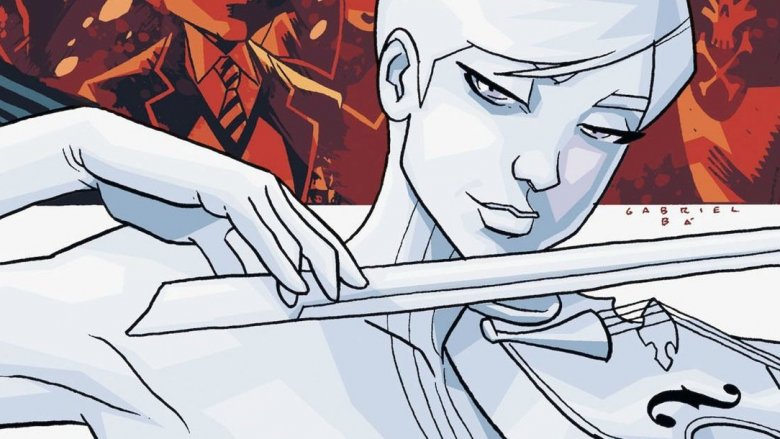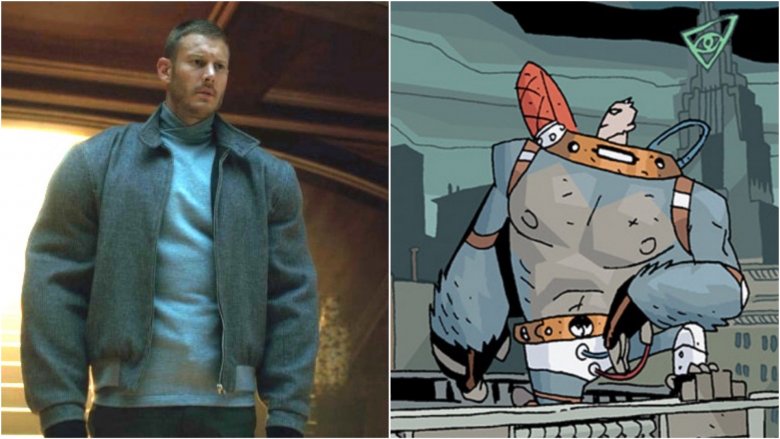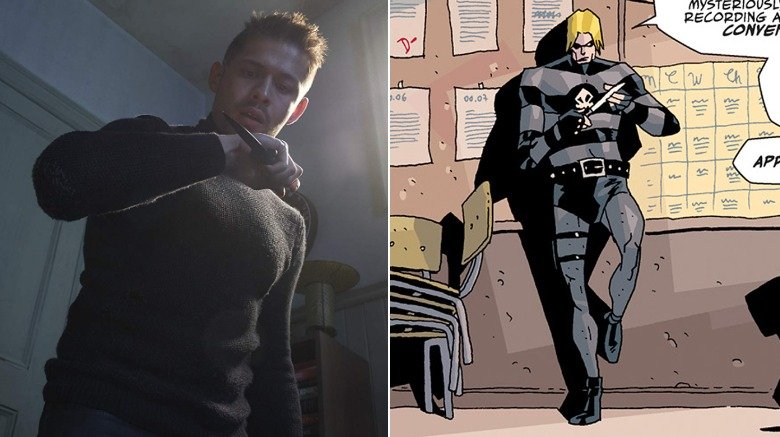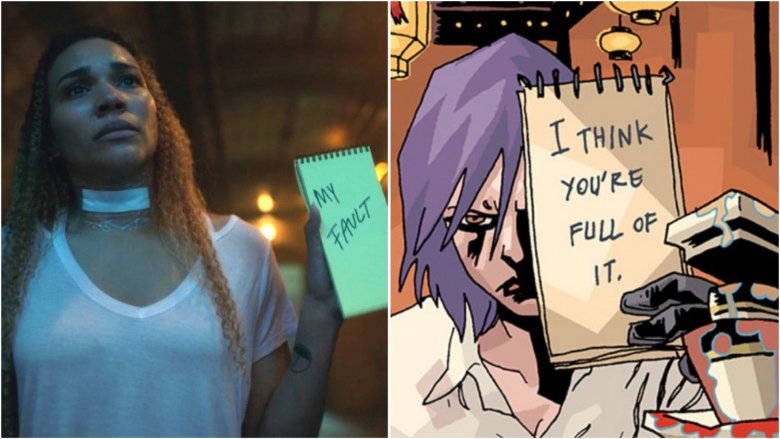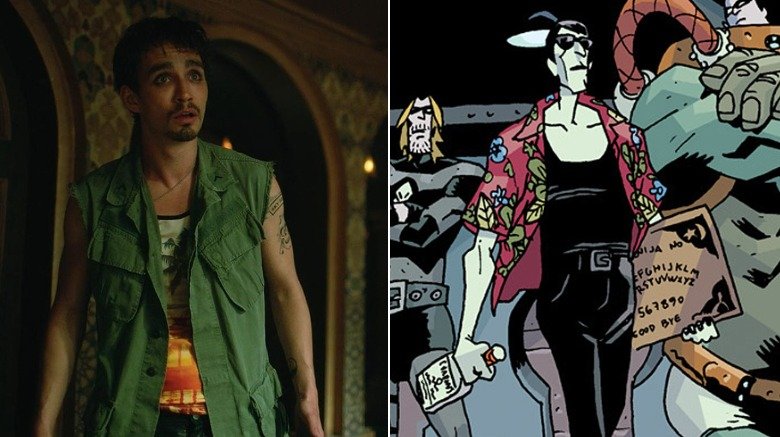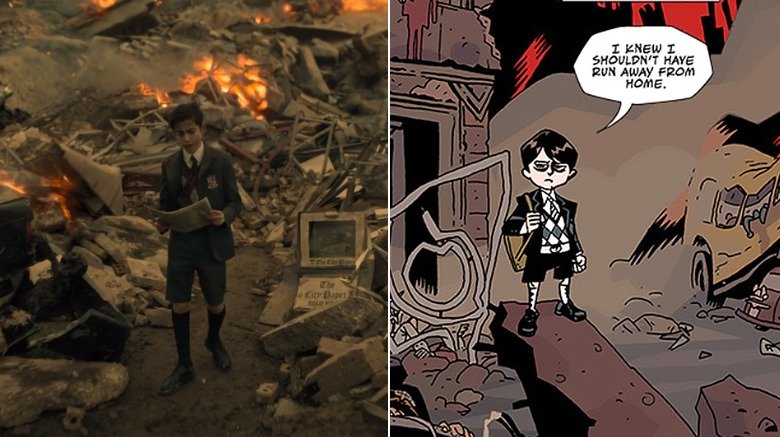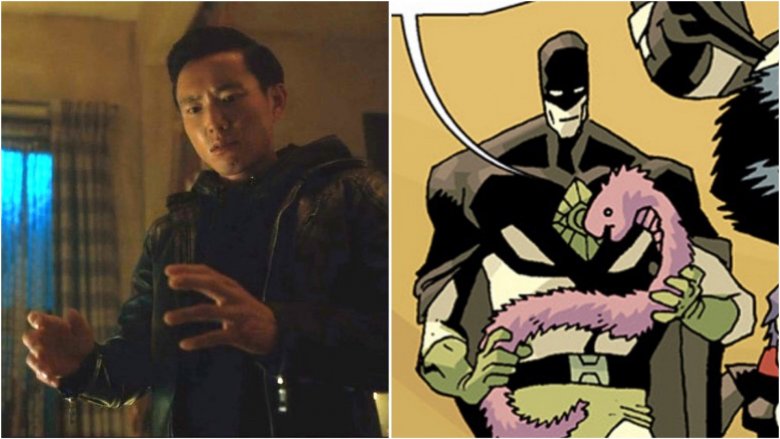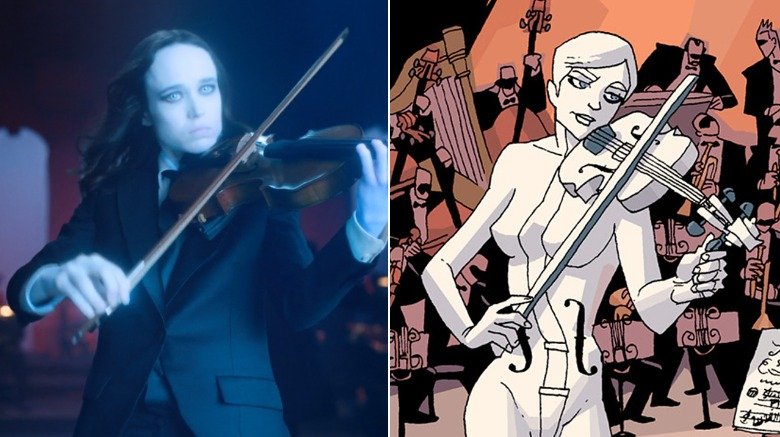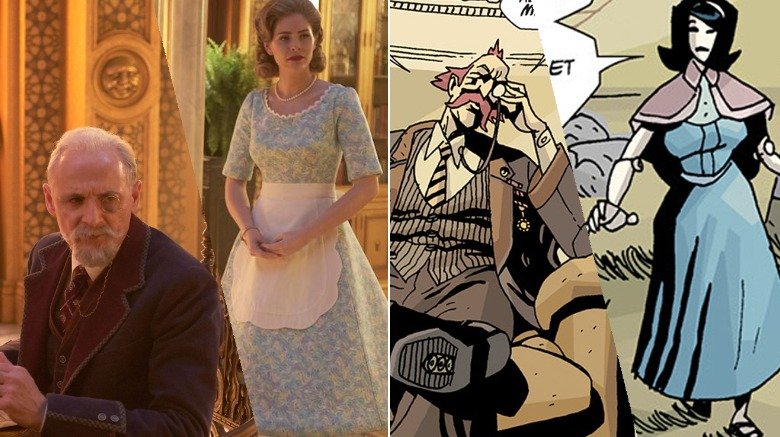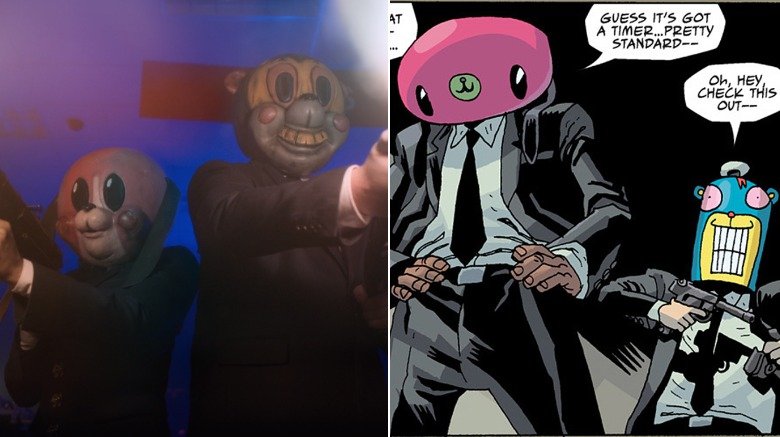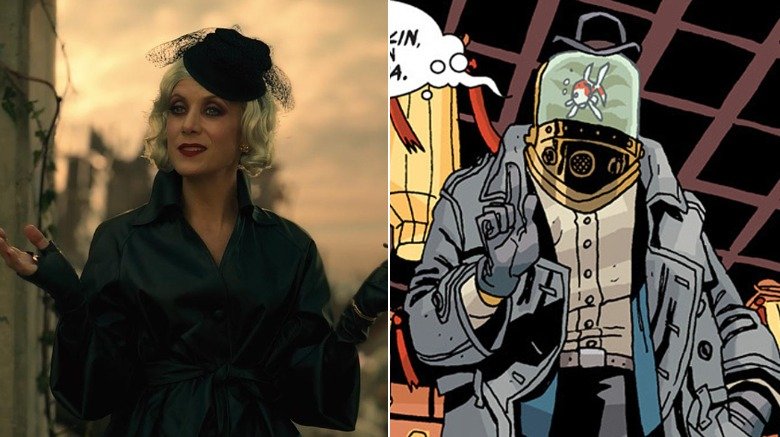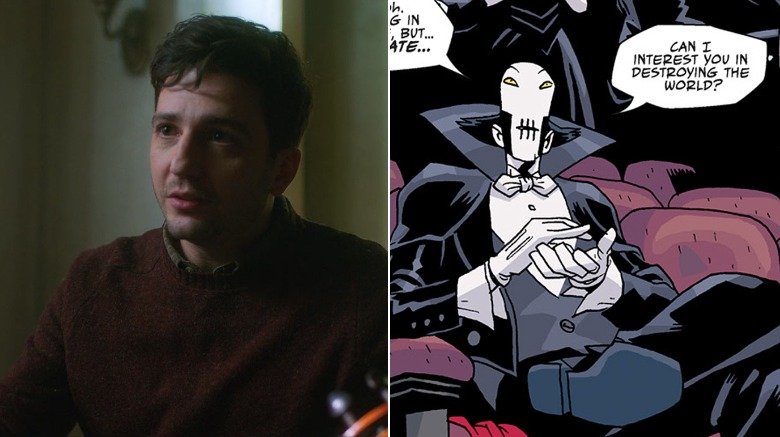How The Umbrella Academy Cast Should Really Look
The Umbrella Academy is one of the most wonderfully bonkers comic series of all time. The first arc alone features talking monkeys, time travelers, ghosts, aliens, and a special song with the power to destroy the world. The fact that it was adapted into a television series is already a small miracle — that it was able to do so with so many of the comic's weirdest elements totally unchanged is even more surprising.
That said, not everything about the Netflix series is faithful to co-creators Gerard Way and Gabriel Ba's original vision. Many key elements of the design of major characters have been completely overhauled for the switch to live action. The motivations behind most of these changes are pretty easy to understand, but a few are just puzzling.
To help you sort through it all, we're here to run down each of the major characters in The Umbrella Academy and compare their appearance on the TV show to their original comic designs. You'll see that some of them underwent a dramatic transformation in the jump from page to screen, and some remained remarkably the same.
With the potential apocalypse coming any day now, there's no time like the present, so let's get started. Here's how the cast of The Umbrella Academy should really look.
Luther / Spaceboy
We all know that Luther, as portrayed by Tom Hopper, is a massive slab of a man in the Netflix series, but believe it or not, his ludicrous physique was actually toned down from his original comics incarnation.
In the show, Luther's beefy body is always covered from the neck down. When we finally see him shirtless, the reason for his modesty becomes clear. In addition to being inhumanly muscular, Luther is covered in patches of hair that give him a somewhat ape-like appearance. He eventually reveals how he came to look this way: After Luther sustained fatal injuries while crimefighting, his father gave him an experimental injection to save his life, and mutating into a giant bodybuilding Neanderthal was an unfortunate side effect.
The Luther of the comics has a far more inhuman appearance, which was the result of a far more extreme life-saving operation. In that continuity, Luther's entire head was surgically removed and transplanted onto the body of a gorilla — a Martian gorilla, incidentally. This version of Luther doesn't bother covering up his unusual appearance, possibly because it's pretty much impossible for him to do so. Also, one additional benefit of being an actual gorilla, instead of just resembling one, is that the comics version of Luther has prehensile feet, which — as you might imagine — end up being "handy" in a variety of situations.
Diego / The Kraken
Although both versions of Diego are equally broody on the inside, the Netflix Diego and the comics Diego diverge on the outside in three major ways.
First up, physical appearance. Live-action Diego is played by David Castañeda, a Latino actor with dark hair, whereas comics Diego is blond and looks much more Caucasian. The show Diego also has a noticeable scar on the side of his head, which his comics counterpart lacks.
Second, his outfit. Comics Diego has one of the most memorable costumes of the family, a long-sleeve shirt with purple and black horizontal stripes and a prominent logo. In the show, it usually looks like Diego is wearing solid black, but it's difficult to say what color any part of his outfit is, given how much time he spends lurking in shadows. In those rare instances that Diego finds himself somewhere with decent lighting, he sometimes wears a shirt that has some subtle stripes on it, but they're certainly not as visible as they are on his comics outfit, and he never has the logo.
Finally, his powers. The Diego of the show seems to have the ability to steer objects with his mind after throwing them, typically knives. Despite being similarly fond of knives, comic book Diego's powers don't relate to this affectation. Instead, he has the ability to hold his breath indefinitely. That's why this version of the character has the code name "Kraken," which he does not seem to share with his television counterpart.
Allison / The Rumor
In the Netflix series, Allison is played by Emmy Raver-Lampman, a fantastic actor — and, as episode six showcases, a dancer who rose to prominence on Broadway as a cast member on Wicked, Hamilton, and the SpongeBob SquarePants musical. She is also one of several actors who helps bring the white cast of the original comic some much-needed diversity. The Allison of the comics is, like pretty much everyone in that story, caucasian.
Another change to the Rumor's appearance is her hair. Unlike her television incarnation, who has dyed blonde hair, comic book Allison has purple hair. This seems to be natural, too, because even in flashbacks depicting her as a baby, she's still sporting her purple 'do.
The biggest remaining difference between these two Rumors are their personalities. In the show, Allison has a dark secret. She used her mind control powers for personal gain constantly when she was younger, to gain wealth and fame and, most shockingly, to modify the personality of her daughter. She came to deeply regret this, and thus grew into a melancholy adult with a deep aversion to her own abilities.
Allison from the comics is more confident, and hesitates far less before using her powers. She get less backstory than her live-action iteration, but it's reasonable to assume that this version of Allison has fewer hangups because she never abused her powers, and subsequently hit rock bottom, to the same degree.
Klaus / The Seance
If you think that Robert Sheehan's portrayal of Klaus looks a little pale and sick at times, he's got nothing on the comics version of the Seance. The original incarnation of the character has stark white skin — a physical manifestation of his connection to the world of the dead.
There is a sequence in the show, however, that might be an homage to his original look. In episode seven, Klaus dies for a bit. While in the afterlife, everything appears in black and white, except for Klaus's clothing. Because of this, his skin appears stark white against his colorful clothes, just like it does in the comics. Apart from the goatee, he's a dead ringer!
Additionally, this version of the character usually gets around by floating through the air rather than walking, and sometimes even his possessions are seen floating along beside him. Due to the blistering fast pace of the comic, exactly how this power works is never explained, but it seems to be totally absent in the television adaptation. Then again, the last couple episodes of the first season have shown Klaus's powers expanding greatly since he got sober. Who knows? Maybe once he gets his six month chip, the television version of this character will start getting high in a far more healthy and more literal sense.
Number Five
Number Five is one of the most wonderfully mind-bending characters in this entire cast of weirdos: a bitter time-travelling 58-year-old man trapped in the body of a 13-year-old boy, played by a 15-year-old Aidan Gallagher.
He is perhaps the only Hargreeves child whose appearance was entirely unchanged during the adaptation: still just a little boy in a school uniform, tiny shorts and all. It seems Number Five's appearance might not just be consistent across space and time, but also across different mediums.
The only real difference between these two Fives is that his comics incarnation engages in slightly more explicit debauchery, but we understand why the series cut that back a bit. It probably would have been a little much, even with the TV-MA rating, to show a real-life teenager hiring a sentient chimpanzee sex worker to dress as Marilyn Monroe and sing "Happy Birthday" to him onscreen, which does in fact, happen in the comic. Incidentally, there are an abundance of sentient speaking primates in the comic beyond just Pogo. It's a whole thing.
It's also definitively stated in the comic that Number Five has stopped aging. In the show, his age was just "reset" to 13, implying that he's probably still aging normally. From the logistics of an ongoing television show, this change also makes sense. It's already a bit of stretch that this 15-year-old is playing 13. Imagine how bad that would get once this show reached its sixth season.
Ben / The Horror
Despite being dead since before the story started, the character of Ben, played by Justin H. Min, appears sporadically in the Netflix adaptation as a ghost that haunts Klaus and tries to serve as his conscience when he isn't being totally ignored. Because of how infrequently he appears, even after the end of the first season, we still don't know much about him.
If you were hoping that digging into the comics would give you more information of what's up with the Horror, then we're sorry to disappoint you — he gets even less attention in the original version of the story. There are only scattered lines of dialogue that refer to him, and only a handful of comic panels that depict him; in most of them, his face is covered by his superhero mask.
The only notable difference that we can confirm is that the comics Ben has naturally stark white hair, unlike show Ben's dark hair. It's difficult to say definitively whether the Horror of the comics is supposed to be Asian like the actor who portrays him, but given how universally white the rest of the cast of the comic is, it's probably a safe bet that this was a change made by the creators of the show.
Vanya / The White Violin
Given that she's ostensibly "the normal one" of the group in both tellings of the story — at least at first — Vanya Hargreeves looks fairly similar in her two incarnations. The main difference between them is that the show makes it much more prominent in her mannerisms and the way that she dresses that Vanya supposed to be shy and plain-looking. Even after becoming a supervillain, the Vanya of the show dresses fairly conservatively, in a three-piece suit.
In the comics, despite being ostensibly "the normal one," Vanya's posture and dialogue always conveys confidence from the beginning. Then, once she becomes a full-on villain, she becomes an unrepentantly murderous diva who delights in making her siblings suffer to a much greater degree than the her more measured and sympathetic incarnation from the show. Vanya also dons a white skintight costume that Elliot Page's more reserved take on the character would never be caught dead in.
The White Violin is a wonderfully cheesy villain in the comics, and her outfit is one of the most simultaneously absurd and iconic character designs of all time. It would be quite impressive to see more of this character's look transferred directly to live action. On the other hand, Elliot Page serving us dead-eyed stares in a tailored suit is fierce!
Mom and Dad
To the casual viewer, Colm Feore's portrayal of Reginald Hargreeves seems totally unchanged from the comics, an old-timey British man with a moustache and a monocle. However, one panel from the comic hints at a significant divergence between these two incarnations of Reggie. It shows Hargreeves in front of his bathroom sink, with his face, an artificial human mask, sitting beside him.
Yes, in both versions of the story, Reginald is secretly an alien. That's what was up with that perplexing first scene of episode eight. It showed Reginald's home planet, shortly before it went Krypton and exploded. However, Reginald and his lover looked just like normal humans during this scene, implying that they are aliens who happen to look like humans, rather than aliens wearing masks. In any other story, that might require explanation, but this is The Umbrella Academy.
Fans of Mom will be happy to learn that the Hargreeves' favorite artificial parent is also featured in the comics. However, this version has dark hair, unlike the blonde Jordan Claire Robbins in the show. Also, comics Mom is more noticeably artificial, with obvious tells such as visible joints and screws on her arms.
And in case you were concerned, the honorary third Hargreeves parent, Pogo, is also in the comics, and he looks exactly the same. Given that this means that the creators of the show had to create a convincing CG talking ape on a TV budget, that's pretty impressive.
Hazel and Cha Cha
The second episode of Umbrella Academy introduces us to two terrifying time-traveling assassins hot on Number Five's tail. Their names are Hazel and Cha Cha, and believe it or not, those ridiculous names are not the simultaneously silliest and most terrifying thing about them. That honor goes to the fact that these two prefer to do their killing while wearing cartoon animal masks — a blue bear and a pink dog, respectively.
Hazel and Cha Cha can be found in the comic book as well, but not until much later in the story. The entire first season of the show roughly maps onto the first story arc of the comic series, Apocalypse Suite. Hazel and Cha Cha don't arrive until the second arc of the comic, Dallas, which will presumably be adapted into the second season of the show.
The two takes on the characters look similar on the surface, down to basically the same blue and pink masks, but in the comic, the surface is all we ever get. Hazel and Cha Cha are only present for a few issues, and only as pure antagonists, so we don't get to know them as people, or even ever see them without masks on.
Fortunately, the extra time that the writers have on their hands with this television series, combined with the fantastic performances by Cameron Britton and Mary J. Blige, mean that the Hazel and Cha Cha of the Netflix series are, if you'll pardon the pun, far better executed.
The Handler / Carmichael
One of the largest looming antagonists in both versions of The Umbrella Academy is the time travel enforcement bureau that employs Hazel and Cha Cha, along with a variety of other villainous agents and hitmen. In the Netflix series, this organization is known as the Commission. It runs entirely on 1950's tech, such as typewriters and pneumatic tubes, and the boss of the whole thing is a woman only ever referred to as the Handler, a statuesque ice queen who dresses in mid-century business attire and a pillbox hat, played by Kate Walsh.
In the comic, we know less about the organization, and its leader is much stranger. (You might be noticing a trend at this point.) The equivalent organization is called the Temps Aeternalis, and we don't see whether or not their offices are similarly stuck in the 1950's, but we do get to meet their leader, a fellow by the name of Carmichael.
Although he and the Handler are equally fond of delivering icy ultimatums to the unfortunate Hargreeves children, Carmichael isn't a towering blonde beauty, or even a human at all. Instead, he's yet another talking animal. Those of you who had money on "primate," sorry, but today is not your lucky day. Carcmichael is a Shubunkin goldfish in a fishbowl sitting on the shoulders of some sort of artificial human body. As you might imagine, this is never explained. It remains yet another delightfully odd touch in this inexplicably strange setting.
Leonard / The Conductor
The character of Leonard from the Netflix series doesn't appear in the comics, but there is an equivalent comics baddie who helps transform Vanya into the villainous White Violin.
In the TV series, actor John Magaro gives a frighteningly realistic portrayal of perhaps the most subtly insidious form of domestic abuse, the kind that hides behind a smile. At first, Leonard looks like a down-to-earth, trustworthy man — a "nice guy." But then, Leonard slowly starts gaslighting Vanya, pushing her to cut ties with the rest of her family, until only he remains as a stabilizing force in her life, all under the guise of wanting to help her. Because of this approach, Vanya's slide into supervillainy in the series is a slow one.
In the comics, the closest Leonard analogue is a mysterious man known only as the Conductor, who dresses in a three-piece suit with a long tailcoat and wears a frightening skull mask at all times. Because of this, as you might imagine, The Conductor is plainly evil from the beginning, far more blunt in his methods than the unassuming Leonard. He comes to Vanya cold with a totally transparent proposition to get revenge against the rest of her family, something that the show's Vanya would never agree to do. Fortunately for him, comics Vanya needs far less prodding to turn to the dark side.
In the end, both these guys end up being pretty evil, but at least the Conductor was a straight shooter.
